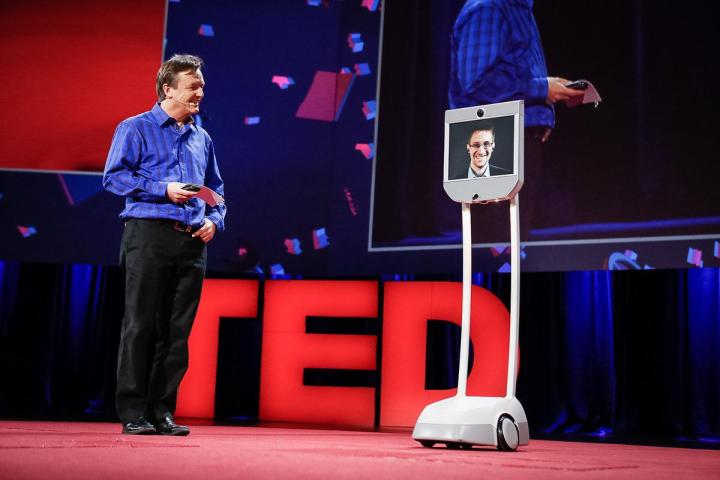
I take it back – I take it all back.
The Beam teleconference robot is not the “douchiest product” of all time, as I so cynically claimed after seeing it in action during the 2014 Consumer Electronics Show. In fact, it’s amazing – so amazing that its use by NSA whistleblower and eloquent fugitive badass Edward Snowden at this week’s TED Talks made me realize an idea that is both astonishing and, somehow, already a normal part of 21st century life: Thanks to technology, we are not longer merely humans at all. We are cyborgs. The line has been crossed.
Using Beam’s keyboard-powered interface, Snowden wheeled around the stage, giving himself a better look at the audience.
Beam, if you haven’t yet encountered it, is a “remote presence system” made by Suitable Technologies, and first launched in 2012. The $16,000 contraption has an iPad-like screen for a face, multiple Internet-connected cameras, and has wheels that allow users to pilot around a room (or, in Snowden’s case, a conference center).
The company touts many uses for Beam – eliminating the need for business executives to travel to international offices, allowing doctors to better treat quarantined patients, remote learning for university students – all of which I dismissed as secondary to Beam’s eerie presence after experiencing it on the show floor of CES. In retrospect, I realize that I was simply being an unimaginative jerk.
The next time I came across a Beam was this week, while streaming TED Talks to my TV with Google Chromecast. (Highly recommended, FYI.) Thanks to the Beam, Snowden appeared on stage in Vancouver for a 35-minute interview with TED head Chris Anderson. Using Beam’s keyboard-powered interface, he wheeled around the stage, giving himself a better look at the audience. He shifted his digital gaze to have a quick chat with Sir Tim Berners-Lee, father of the Web, who had a brief on-stage cameo. He wore, below his screen, a big name tag that read “Edward Snowden, citizen.”
Seeing as this is a TED, home of next-generation ideas and thinking, it is easy to take this futuristic scene for granted. But let’s just pause for a moment to reflect on what took place: From a secret remote location in Russia, Snowden, one of the most sought-after fugitives from the U.S. government, gave an interview, chatted with the inventor of the Web, tooled around on a stage some 5,000 miles away, then mingled with the TED crowd, and even had his picture taken with Google’s Sergey Brin.

That is goddamn incredible.
Without the Beam, most of that would have been impossible. Yes, he could have still done the interview part, like he did at SXSW. But he certainly couldn’t have taken selfies with TED-goers. And, I imagine, it wouldn’t have felt like he was really there. Even from my remote location (on my couch), Beam-Snowden seemed like a person, like a living being occupying space around other living beings. He wasn’t just a face on a screen.
This idea that we are already cyborgs – an interdependent mix of man and machine – is not new. But it is part of our reality. Just snatch a smartphone away from a 16-year-old, and you’ll see that neither function well without the other. Nor is it novel that technology allows us to do things that were previously impossible – that’s the point. But Beam-Snowden is something different; he (it, whatever) existed in a place outside his body. He did, in fact, go to Canada.
Snowden’s TED appearance is fundamentally different than what your average telecommuter does on a daily basis. I, for example, live and work in upstate New York, hundreds of miles away from my nearest colleagues. When I have Skype chat with, say, DT’s mobile editor Jeffrey Van Camp, I am not zipping through the ether into the room with him. Were I to teleport myself into a Beam that’s next to him, however, the feeling would be entirely different – it would be as if I were there – even if the nuts and bolts of the communication are essentially the same.
Doing this, said Itskov, will allow us to travel anywhere on the globe – anywhere in the universe – instantaneously.
Last year, I had the pleasure of attending the Global Future 2045 Congress, created and funded by Russian super-wealthy-guy Dmitry Itskov, which proselytized the transhumanist “transition to neo-humanity” through which human consciousness is transplanted into computers. Doing this, said Itskov, will allow us to travel anywhere on the globe – anywhere in the universe – instantaneously.
“We will be able to travel just by transferring the consciousness to a new body,” Itskov told me at a lunch meeting last March. “Look at Iron Man, look at his suit. I think bodies of the future will be able to travel like that. This body won’t need any shelter. The food will just be for memories, for pleasure, just for fun.”
At the time, Itskov’s dreams seemed like a wild idea, a vision of the far-off future that may or may not ever come true. Snowden and Beam just showed that that future has already arrived. It just looks a bit sillier than we might have imagined.
(Images via Bret Hartman/TED, Chris Anderson/Twitter)


